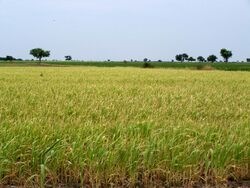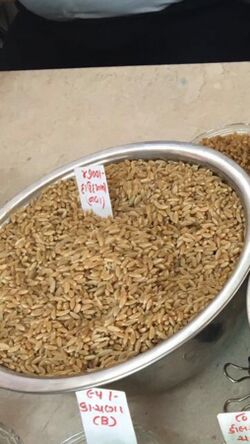Biology:Bhalia Wheat
Bhalia Wheat, also known as Daudkhani Wheat is a type of long grain Wheat cultivated in Bhal region in the north of Gulf of Khambhat, Gujarat, India. It received registration as Geographic Indication in 2011.[1]
Location
Bhal region is situated between Ahmedabad and Bhavnagar districts[2] where this wheat are cultivated starting much before independence of India.[3] They are widely cultivated in Dhandhuka, Dholka and Bavla talukas of Ahmedabad district; Limbdi of Surendranagar district; Vallabhipur of Bhavnagar district; Tarapur and Khambhat of Anand district; Matar of Kheda district; Jambusar and Vagra of Bharuch district.[4]
Bhalia Wheat were registered as Geographic Indication in 2011 with help of state-run Gujarat Agro Industries Corporation and Anand Agricultural University. They are widely used for preparing semolina which is used for making pasta, macaroni, pizza, spaghetti, vermicelli, noodles etc. Gujarat Wheat-1, a variety of Bhalia Wheat, is popular in Gujarat.[4]
Production
The sowing starts in late October to the first week of November after rain water gets drained to the gulf. The produce is reaped in March — April. Every year 1.7 to 1.8 Lakh (170,000 to 180,000 long tons) of wheat is produced across 2 lakh hectares (490,000 acres). Bhalia wheat does not require irrigation or rain as they are cultivated on conserved soil moisture.[4]
Nutrition
Bhalia Wheat are rich in Gluten, a type of amino acid. It is also rich in protein. It has high amount of carotene and has low absorption of water.[4][5]
References
- ↑ Gautam Purohit (16 August 2011). "કેસર કેરી પછી હવે ભાલીયા ઘઉંને ‘જીઆઇ’ ટેગ અપાયો" (in gu). દિવ્ય ભાસ્કર. http://www.divyabhaskar.co.in/news/MGUJ-AHM-c-69-784023-2357368.html. Retrieved 26 January 2016.
- ↑ "GI tag for Gir Kesar mango, Bhalia wheat". 28 July 2011. http://timesofindia.indiatimes.com/city/ahmedabad/GI-tag-for-Gir-Kesar-mango-Bhalia-wheat/articleshow/9390931.cms. Retrieved 27 January 2016.
- ↑ George Watt (23 January 2014). A Dictionary of the Economic Products of India. Cambridge University Press. p. 136. ISBN 978-1-108-06881-9. https://books.google.com/books?id=HChOAgAAQBAJ&pg=PA136.
- ↑ 4.0 4.1 4.2 4.3 "Bhalia wheat gets GI tag". Business Line - The Hindu. 15 August 2011. http://www.thehindubusinessline.com/economy/agri-business/bhalia-wheat-gets-gi-tag/article2358793.ece. Retrieved 26 January 2016.
- ↑ "Geographical Indication tag for Bhalia wheat". The Indian Express. 17 August 2011. http://archive.indianexpress.com/news/geographical-indication-tag-for-bhalia-wheat/833018/0. Retrieved 26 January 2016.



